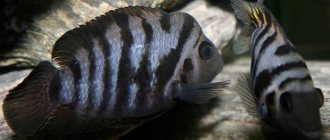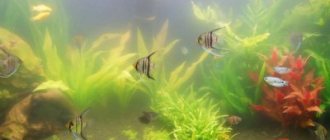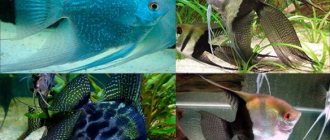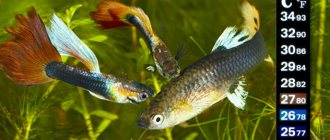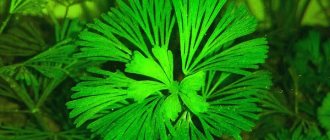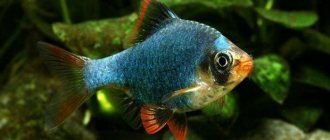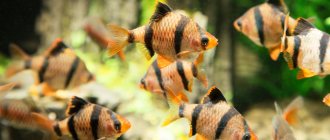Habitats
Metriaclima estherae, also known as Esther Grant's zebra, was described by Konings in 1995 and lives in Lake Malawi (Africa). The researcher named the species after Esther Grant, the wife of ichthyologist Stuart Grant.
Although a significant portion of the Metriaclima estherae population lives near Minos Reef, some individuals can be found in Meluluca (Mozambique, Africa). Like most other mbuna, the fish likes to live in rocky places where it can find its favorite algae, aufwux. Aufwux are long algae that grow on rocks. They may contain insect larvae, nymphs, crustaceans, snails, mites and other zooplankton.
It is worth noting that this cichlid is known in science under three different names. This is a problem that has not yet been resolved. When the species was first discovered, it was dubbed Pseudotropheus estherae and classified as part of the genus Pseudotropheus, which contained a subgroup of related fish called "Zebras".
Later it turned out that the fish are not so close, and in order to separate “Zebras” into a separate genus in 1984, it was decided to call them Mailandia. This name comes from the surname of the famous ichthyologist - Hans Mayland. But there were also problems with this name, as it did not meet some of the requirements provided for scientific names. Therefore, it was given the status of "nomen nudum", meaning that the name cannot be used as a scientific name. However, this issue is still under discussion.
In 1997, it was decided to rename the fish Metriaclima. As before, there were also problems with the name. In this case, the requirements for changing scientific names were not met. In particular, the designation is not submitted to official bodies for approval. Although Metriaclima is now the scientific name, all dissenters have the right to use the former name. Therefore, both late 20th century names, Metriaclima estherae and Maylandia estherae, are considered correct, and in some circles even Pseudotropheus estherae is used.
Description
Red zebras can live up to 10 years. Their body is elongated and resembles a torpedo in shape. The coloring of males and females is not the same; there are several different colors: males of the “red-blue” breed are colored light blue with faint vertical stripes and 4-7 round dots near the anal fin. The fry of this variation are easiest to distinguish from each other - males are born dark brown, and females are pale pink.
Males of the "bright red" breed can have not only red coloring, but also red-orange without any vertical lines. Their fry are born with the same coloring as the female, but after the males reach 6 cm in length, they begin to change color.
There is also a breed of “albinos”, but they are extremely rare in the wild. Females can be yellow, orange, or orange with dark speckles. Also, they have up to three large points near the anal fin.
Main characteristics
Among the many sea creatures that are suitable for aquarium keeping, the lionfish is considered the most interesting. Despite its name, the animal cannot fly, but it boasts amazing beauty and a specific way of life.
Other fish names include:
- Zebra aquarium;
- Lion fish.
Despite its name, the lionfish cannot fly.
Such an interesting name is explained by its large large fins, reminiscent of a lion's mane. There are also numerous stripes along the body of the lionfish, which give it a special gracefulness. The creature belongs to the order of scorpionfish of the cichlid family (the “mbuna” group of Malawian cichlids).
In the wild, the size of the fish reaches 30 cm and its weight is 1 kg. The incredible appearance is emphasized by wide stripes, an elongated body shape, large eyes and head. The fish also has rather thick lips and a terminal mouth. The range of colors is very extensive. Today, ichthyologists count more than 50 color options for lion fish. The most popular options include the following:
- Blue - The blue zebra cichlid is considered an excellent find for aquarists.
- White.
- Red zebra - the fish looks simply amazing, which deserves special respect from ichthyologists.
- Orange-red.
- Yellow-orange.
A distinctive feature of the species is the ability to change color depending on the mood.
A distinctive feature of the species is the ability to change color depending on the mood and age of individuals. Being a predatory fish, the cichlid is capable of eating fry with sizes up to 2/3 of the length of its own body. Noticing the prey, it rushes at it and attacks with sharp needle-feathers, which are located in the dorsal and pectoral fins. After such a collision, the prey begins to experience incredible pain and a serious deterioration in its general condition. Soon paralysis of the respiratory and skeletal muscles occurs.
Aquarium zebra fish can grow up to 15 cm in length. At the same time, for the full development of the creature, it is necessary to use aquariums with a capacity of 150 liters or more.
Feeding the red zebra
Representatives of the species Metriaclima estherae are omnivorous aquarium fish, but they require plant products on an ongoing basis. Although zebras can feed on zooplankton in the wild, the majority of their diet should consist of vegetables or similar foods. They will be happy with any food of this kind, but in order for the body color to remain bright, it is necessary to add fortified food, spirulina, cyclops or any high-quality food for cichlids. Sometimes you can give your fish shrimp or brine shrimp nauplii. It is worth noting that zebras get fat very quickly, so you should not overfeed them.
In addition, Metriaclima loves algal fouling, so food costs will be lower than in the case of carnivorous cichlids. It is recommended to feed the fish more often, but in small portions that will be quickly absorbed and will not spoil the water. The diet requires vitamins and animal food, but you should not overdo it with proteins because the fish may suffer from bloating.
In the following article you can learn about the feeding behavior of Metriaclima and their differences from other mbuna.
Varieties of Malawian cichlazoma
The most common is the red zebra psefdotropheus. Contrary to the name, the fish are blue-blue and beige-brown. They are called zebras because of the stripes that run throughout their body. Sometimes the body of a red zebra is monochromatic. Such individuals are usually colored blue, red, yellow or white. Female zebras most often have spots on their bodies and are rarely monochromatic. The body length of the red zebra pseudotropheus fish is 12 cm.
We recommend reading
Aquarium fish cardinals: maintenance and care
The second most popular species of cichlid is called brown pseudotropheus, or fuscoides. They are slightly smaller than their predecessors: their body length is only 10 cm. They are painted in dark brown, lilac-beige, as well as yellow and lemon colors.
The most luxurious representatives of cichlids are agate pseudotropheus. They are blue-black in color and have a yellow-green border on their fins. The fish grow to medium size. Female representatives of such cichlids have a pattern with crosses and strokes.
Keeping a red zebra in an aquarium
Metriaclima estherae requires an aquarium of at least 250 liters in size with a length of 122 centimeters. If representatives of this species are not the only inhabitants of the aquarium, even more space will be required. Zebras are comfortable with fresh or slightly brackish water; the main condition is to ensure a constant flow of water along with its effective filtration. You should definitely add corals or sand to the aquarium - they will help keep the pH at a high level. You can also use gravel. Stones and driftwood are useful for building a large number of passages and places where fish could hide. This will help reduce the aggression of individuals and divide the territory. The red zebra loves to dig in the ground, so stones should be placed on top of the sand rather than buried inside.
Poor water quality will immediately affect the health of cichlids. Since the Red Zebra is sensitive to the composition of the water, it is necessary to change 30% of the water weekly (depending on the number of animals in the aquarium) and clean the walls of the aquarium every two weeks. If the fish show increased aggression, we can recommend changing the location of shelters and holes, which will lead to disorganization of the community and a new redistribution of the territory. Bloating in Malawian cichlids is a typical disease for these fish, characteristic of individuals whose diet is dominated by products of animal origin rather than plant products. Red Zebras suffer from many other diseases common to all freshwater fish.
Necessary conditions of detention
The rivers flowing into Lake Malawi are high in various minerals. Due to this and the large amount of evaporation, the water in the lake has a high content of alkalis and minerals. The lake is known for its transparency and stability of many chemical indicators, such as pH. This makes it clear why it is necessary to monitor the water parameters in an aquarium with fish from Lake Malawi. The risk of ammonia poisoning increases with increasing pH levels, so you should never forget to change the water in your aquarium. If these requirements are not met, the fish may take longer to acclimate to changes in pH levels.
Hardness: 6-10° dH pH: 7.7 - 8.6 Temperature: 23 -28° C
We create normal conditions for pets
It is very easy to create conditions in an aquarium for zebra pseudotropheus. You need to buy a 2000 liter aquarium with an aerator and filter. Place large stones at the bottom, create grottoes and caves.
The temperature should be stable, not lower than 23-24 degrees. Set the acidity in the aquarium to 7.5-8.5 pH, and hardness to 15 dH.
We recommend reading
Care, maintenance and compatibility of gourami
Change 1/4 of the water in the fish's housing every day. This condition is met even when only fish live in the container.
For adult fish, lighting in the aquarium is not particularly important. The main thing is that they have a place where they can hide if it is too light.
Compatibility of zebra cichlids with other fish
This mbuna is not what you would call friendly. The best combination of individuals is 1 male and 2-3 females. If other types of nimble fish are used in the aquarium to reduce aggression, frequent water changes are necessary. Metriaclima estherae can be kept together with other less aggressive mbuna from Malawi, but only if they are of different sizes and are not similar in appearance, otherwise clashes or crossings with the formation of hybrids may occur, which is highly not recommended. Also, under no circumstances should zebras be kept together with Haplochromis, since zebras, like all mbunas, are very aggressive towards them.
Male red zebra on top and female below (photo by Michael Persson)
Popular types
In nature, there are more than 50 subspecies, but only unpretentious owners of bright colors are bred at home. The most popular are:
Double red or red-red
The representative of the species belongs to the Mbuna group. In natural conditions it is found off the coast of Mozambique. The elongated body, flattened on the sides, does not exceed 10 cm. The color of the scales depends on the sex: males have a light blue color with vertical stripes and spots on the anal fin. Females are red-orange or brown-beige. The species is aggressive and enters into battle even with its own relatives. Features of the species - life expectancy is 10 years.
Pindani
A soft blue fish with dark transverse stripes and a dark blue border on the fins. Sexually mature males can be distinguished by bright spots on the anal fin. As the male grows, the color fades and becomes less bright. Compared to other species, the fish is calm, unpretentious and adapts well to various conditions.
Lombardo
Found in nature near the islands of Namalenje and Mbenj. The 10 cm body of males is yellow with dark longitudinal stripes. Females are blue, also with stripes. To maintain a flock you will need an aquarium of over 200 liters. To reproduce, 1 male needs 2 females.
Sualosi
A miniature species, reaching a length of no more than 8 cm. The color of males is bright yellow, and that of females is blue with dark vertical stripes. In nature it is considered an extinct species.
Maingano
A bright, beautiful fish reaches a length of 10 cm. The body is dark blue with longitudinal blue stripes. The appearance is stubborn and aggressive.
Demasoni
The species is hostile in nature. It grows no more than 9 cm, but despite this, one couple may need a 200 liter aquarium for a comfortable life. The body is dark blue with horizontal sky stripes. The anal fin may be yellowish, brown or sandy in color. Demasoni is the most common type of pseudotropheus!
Pseudotropheus zebra is a beautiful, unpretentious aquarium fish. To comfortably keep 1 flock you need a voluminous aquarium. This species of cichlids often suffers from obesity, so it is necessary to responsibly follow feeding rules.
Reproduction
Red zebras can be bred in captivity. Puberty ends in fish when they reach a size of 7-8 centimeters. If the desired color has not yet appeared in the fish purchased for breeding, you need to take 7-10 pieces at once. To stimulate spawning, spawners should be fed a varied diet twice a day. They also need a calm atmosphere. If Red Zebras are not spawning, then most likely one of the fish is too aggressive and should be removed from the aquarium. The absence of aggressive fish creates a calm atmosphere that promotes the reproduction of Metriaquima.
The female lays 20 to 30 eggs and immediately hides them in her mouth until they are fertilized. The male spreads his anal fin, on which there are points similar to eggs, so that the female, confusing them with her eggs, also tries to hide them in her mouth. By doing this, she stimulates the male to release sperm and fertilize the eggs. Within 2-3 weeks at a temperature of 28°C, the fry are born. The juveniles feed on powdered dry food and Artemia nauplii. At first, the female protects her offspring. In the future, it will be easier for the fry to survive if there is a sufficient number of shelters in the aquarium. The coloring of the “red-blue” fish at first is similar to the coloring of the female. Males begin to change color when they reach 6 centimeters in length. Males of the "bright red" breed are born with a dark brown coloring, and females with a pale pink coloring.
Female red zebra (Metriaclima estherae) with eggs in her mouth (photo by kimonasandrews)
Larvae with yolk sacs (photo by Michael Persson)
—— www.ciklid.org/artregister/artreg_visa_art.php?ID=701 — Michael Persson https://www.flickr.com/photos/kimonas/503282602/in/photostream/ — kimonasandrews
Care and maintenance
Pseudotropheus are unpretentious fish. Their maintenance and care is minimal. But in order for an aquarium fish to be comfortable in an artificially created house, it needs favorable conditions:
- Aquarium size – a minimum volume of 200 liters is required for one flock. It is better to choose an aquarium of an oblong shape; it should be equipped with a lid, since the jumping ability of the fish is high.
- Water parameters - temperature should be between +24-28 ° C, hardness - from 4 to 20, acidity - 7.2 - 8.5.
- In nature, fish live in clean water, so in an artificially created house you need to install a powerful filter and aeration system. Water changes are carried out weekly, changing only 30% of the volume.
- Lighting is set dim.
- Since the fish needs shelter, stones, driftwood, a decorative grotto and caves are installed on sandy soil.
- The zebra's diet includes 60% vegetation. Therefore, ferns are planted in the aquarium, as well as algae with soft and hard foliage.
Cichlids of Malawi gravitate towards rocky grottoes and gorges, apparently their genetic memory reminds them of the bottom of their native lake.
Nutrition
Pseudotropheus is not a predator, but for a healthy lifestyle you need to listen to the advice of professionals. Daily menu:
- 60% - foods of plant origin: bell peppers, lettuce, cabbage and nettles, zucchini and cucumbers;
- 40% - live food: bloodworms, cyclops, daphnia. The presence of live food affects the color of the fish;
- once a week you can give black bread and ready-made dry food. Since they contain a full complex of vitamins and microelements.
When it comes to dry food, preference should be given to ready-made mixtures prepared specifically for cichlids.
To keep your fish healthy, brightly colored and active, it is important to give it a balanced and varied diet.
